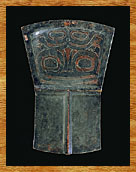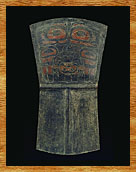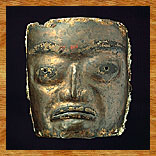
 Clothing Clothing
 Headresses Headresses
 Raven Rattles Raven Rattles
 Copper Shields Copper Shields |
Copper Shields
Copper was the ultimate symbol of wealth among the Haida and is associated with Copper Woman of Haida myth. Throughout the coast, shields made of copper were exchanged at ever higher values between chiefs at potlatch feasts. Among the Kwakwaka'wakw (or Kwakiutl) to the south of Haida Gwaii, coppers were particularly associated with the distribution of wealth at wedding feasts. The Haida used coppers as a marker and symbol of wealth, and some wealthy chiefs owned a dozen or more.

 |
This beautifully engraved copper depicting a Sculpin is a classic Haida object. The bulbous top panel displays the crest of the owner, and the well-fashioned T-bar in the lower half represents the backbone of an ancestor.
Acquired from the Kaigani Haida circa 1900 by George T. Emmons for the Lord Bossom collection.
CMC VII-X-1080 (S94-6768) |
 |
A large copper decorated with a double-headed Eagle. The double-headed Eagle is not a traditional Haida crest but was adopted from the Imperial Russian form of this bird introduced by Russian fur traders in Alaska.
Collected from Skedans before 1900 by Charles F. Newcombe.
CMC VII-B-665 (S92-4244) |

In the Prince Rupert harbour shell middens, the use of copper in the form of bracelets, pendants and tubes can be traced back more than 2,000 years and thus appears to be an early feature of north coast trading and warfare. According to tradition, copper came from the territory of the Eyak people in the Copper River area of Alaska, where it occurs with some frequency as pure nuggets in the river gravels.
Alexander McKenzie, the Hudson's Bay Company agent at Masset, recorded the following information, which he elicited from local chiefs:
The original coppers were brought from the northern portion of Alaska, and the tradition is . . . that they were first made out of lumps of native copper which were found in the bed of a river there, but latterly the Indians bought sheet copper from the Russians at Sitka, and also in Victoria, and several natives along the coast commenced manufacturing spurious coppers from this material, which ultimately produced a fall in the value of coppers, and by glutting the market destroyed the romance of the idea that the copper was one of the earthliest rarest and choicest treasures fit only to be purchased by great chiefs.
McKenzie also notes that, among the Haida, each copper had its own name. He records the history of a copper called Taow-kee-ass, which belonged to Albert Edward Edenshaw; it was sold to a Tsimshian chief for eight slaves, one large cedar canoe, one hundred elkskins and eighty boxes of grease.
A number of studies have tried to unwrap the cosmological meaning of the copper shield with varying success. On one level, it represents the ancestors of the owner, and the raised T-shaped bar that divides it is the backbone or skeleton of the ancestors. McKenzie also comments on this feature of the copper:
A conspicuous mark was always on these, the (T) cross, and on the skill with which this was executed depended in a great measure the value of the copper: This T or indentation is called in Haida taow-tsoe-h, namely, "back bone of the taow." It was fashioned by hammering on a wooden pattern by a particular process known only to skilful workers, with the result that when the taow was finished, the indentation of the T was the same thickness as the rest of the copper plate. If the T proved thinner, the value was considerably diminished; in fact, the copper was considered not genuine.
The portion above the T-bar is often bulbous and represents the head of the ancestor/crest, although among the Haida the rest of the body of the crest is often incorporated above the T-bar. The Haida engraved the design deeply into this upper portion and frequently chiselled out the background to provide a higher relief.
Very small coppers were sewn in numbers onto dance aprons and skirts, and the shape of the copper shield was often used for other objects of wealth such as abalone earrings. Neckrings made of copper were popular, and copper figurines of humans were also fairly common, but there are no indications as to their use. They invariably have large heads, sometimes with pierced facial features, and even wear small copper armbands. It is possible they were used in curing rites or by shaman at first salmon ceremonies. Much rarer were copper masks, though similar ones are frequent among the Tlingit.

 |
A copper mask, evidently used in rituals since there is a fringe of eagle down glued with pine pitch around the outer edge. This mask was said to have been dug up at an ancient village site at the south end of Masset Inlet and reused in a ceremony at Masset village.
Collected at Masset in 1884 by Israel W. Powell.
CMC VII-B-108 (S92-4185) |

|